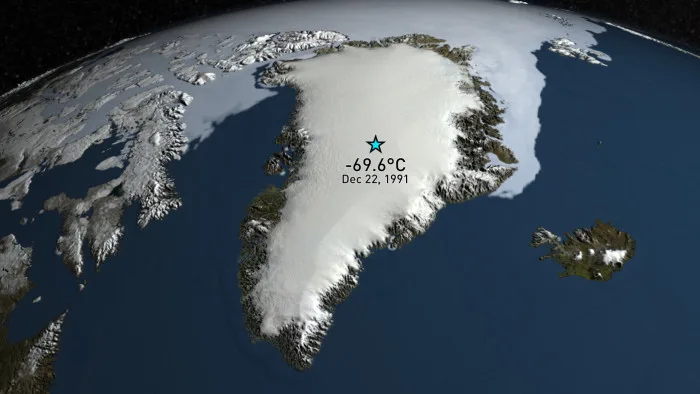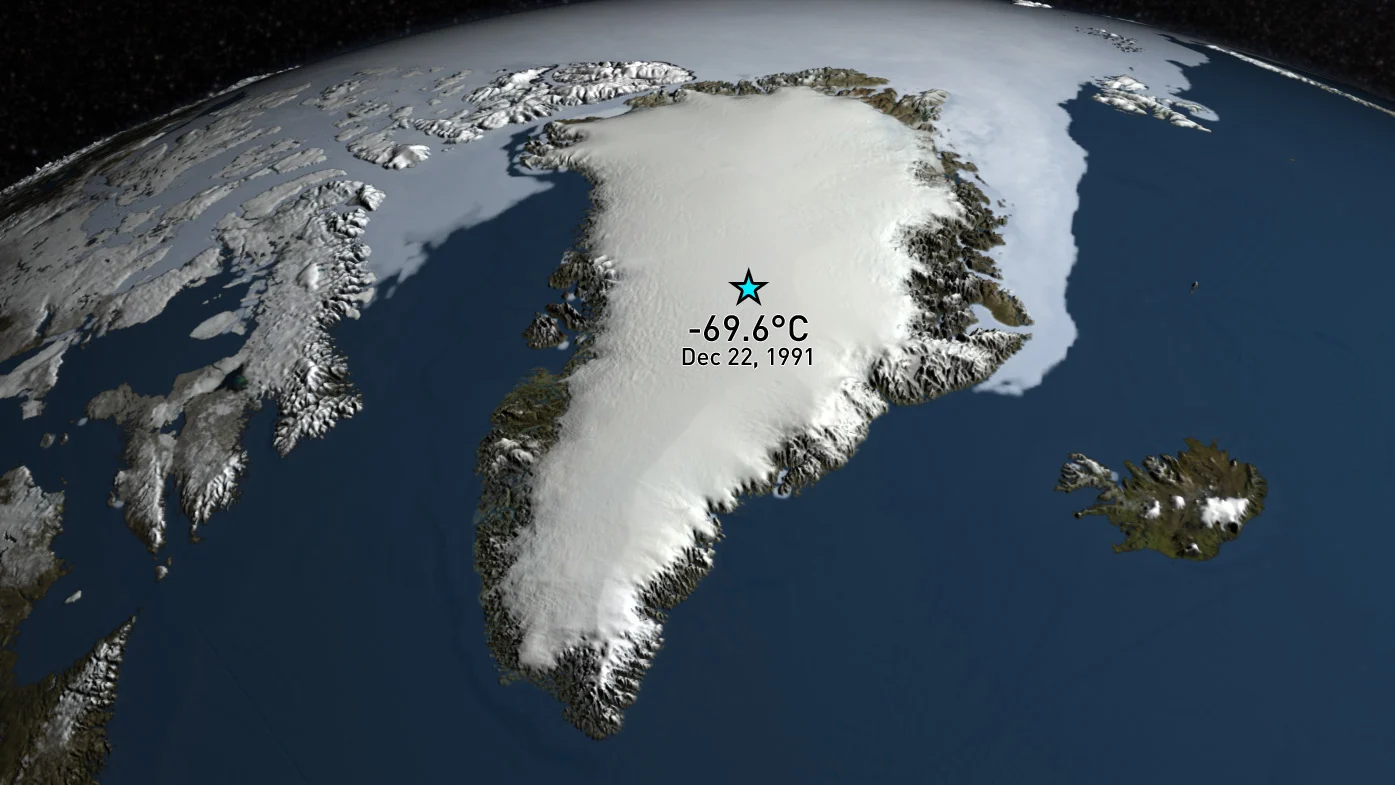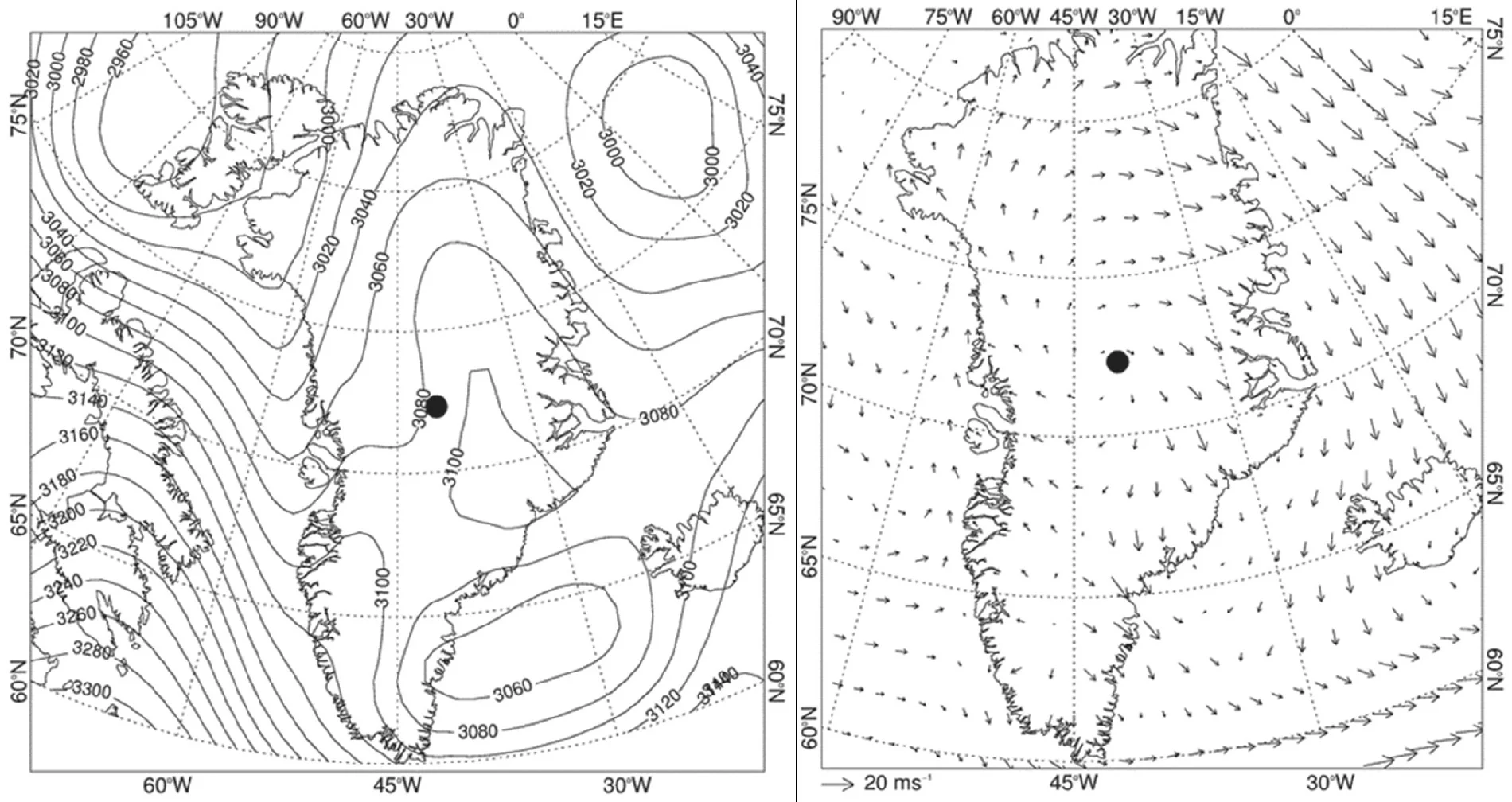
Uncovered after 30 years, Greenland temperature sets new record for extreme cold
This is an important reminder about the stark contrasts that exist on this planet
A new temperature record has been confirmed by the World Meteorological Organization. This time, it's not for heat, but for cold.
Central Greenland is now the record-holder for extreme cold in the Northern Hemisphere. The WMO confirmed on Wednesday that an automated weather station named Klinck, located near the summit of the Greenland Ice Sheet, measured a temperature of -69.6°C (-93.3°F) on December 22, 1991.

Klinck, located at 72°18'N and 40°28'W, at an altitude of 3,105 m, is the new record holder for coldest temperature in the Northern Hemisphere. Credit: WMO (background image provided by NASA's Goddard Space Flight Center Scientific Visualization Studio)
This new extreme beats out the previous record of -67.8°C (-90.0°F), recorded in Russia at both Verkhoyansk in February 1892, and Oymyakon in January 1933. The coldest recorded temperature in the world still stands at -89.2°C (-128.6°F), set on July 21, 1983, at the Vostok weather station in Antarctica.
"In the era of climate change, much attention focuses on new heat records," WMO Secretary-General Professor Petteri Taalas said in a press release on Wednesday. "This newly recognized cold record is an important reminder about the stark contrasts that exist on this planet."
"It is testimony to the dedication of climate scientists and weather historians that we are now able to investigate many of these older records and secure a better global understanding of not only current, but also historical, climate extremes," Taalas added.
According to the WMO, with the establishment of the World Weather and Climate Extremes archive in 2007, this 1991 record temperature was measured well before they began closely monitoring these extremes. In fact, the specific automated station that recorded it had only been on-location for a few years before it was sent back to the University of Wisconsin-Madison, and then was redeployed in Antarctica.
It was only due to the keen eyes of a weather records researcher that this extreme was uncovered and now confirmed.
RELATED: WORLD-RECORD ARCTIC TEMPERATURE LIKELY AS FOREST FIRES RAGE
CLIMATE DETECTIVES
This new record would not have been possible if it weren't for the dedication of climate historians and weather researchers.
The WMO investigation began when this potential record extreme was brought to their attention by weather records researcher Maximiliano Herrera. Herrera keeps a detailed database of temperature records on his personal website, which is a go-to resource for meteorologists and climate experts.
From there, a panel of polar scientists tracked down the original University of Wisconsin-Madison team that installed the monitoring station, 28 years after the fact. Even though nearly three decades had passed, the team was still able to supply the panel with the original calibration records and metadata from the automated station, which was of great value in the panel's investigation. In their report, the panel even included a special commendation for the project scientists for their careful maintenance of these records for such a long period of time.
"Such diligence indicates a high degree of detail and quality of observation," the panel wrote in their report, noting that the uncertainty in the measured temperature ammounted to no more than half a degree, either way.
An analysis of the weather conditions that were present at the time provided further support that the measurement was valid. With an 'omega block' in place over eastern Greenland in late December 1991, this led to weak winds near the surface.
As the WMO team wrote in their report, "together with rapid radiative cooling of the surface, led to the development of a strong, shallow surface‐based inversion and hence very low near‐surface air temperatures."

Geopotential height at the 650 hPa pressure level over Greenland at 00UTC on December 19, 1991 (left) shows the clear omega block over the area. 10 metre wind vectors over Greenland at 00UTC on December 20, 1991 (right) verified the low wind speeds at the station. Credit: WMO
"This investigation highlights the ability of today's climate scientists to not only identify modern climate records but to play 'climate detective' and uncover important past climate records," said Professor Randall Cerveny, Rapporteur of Climate and Weather Extremes for WMO, "thereby creating a high-quality long-term record of climate for climate-sensitive regions of the world."
With this recently uncovered record being nearly 30 years old, conditions on the Greenland Ice Sheet have changed considerably since then.
According to a study published in the journal Nature last year, between 1992 and 2018, the Greenland Ice Sheet lost 3.9 trillion tonnes of ice. A new study, published August 20 in Nature Communications Earth & Environment, added another 532 billion tonnes to this total, just during 2019.
That's over 4.4 trillion tonnes of glacial ice lost since this record was set.
Sources: WMO | Royal Meteorological Society







